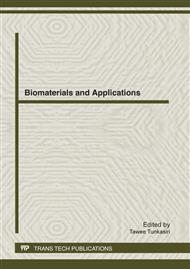p.405
p.409
p.413
p.417
p.421
p.425
p.429
p.433
p.437
Factors Affecting Design of Shellac-Based Matrix Tablet through Annealing Process
Abstract:
The aim of research was to elucidate effect of annealing temperature and shellac (SHL) content on properties of shellac-based matrix tablets. Theophylline was selected as a model drug. The tablets were prepared by direct compression process and then annealed at various temperatures for 24 hours. The tablet properties, including hardness and disintegration time were comparatively. The result demonstrated that annealing temperature directly affected the hardness and disintegration time of tablets. At 60oC or more, the hardness was increased more than 1.5 times as compared to that of un-annealed tablet. The disintegration time was also increased and well correlated with the increased hardness. In addition, the more pronounced effect was observed as increasing SHL content. The more amount of SHL should provide more condensed network that improved cohesiveness and delayed disintegration time of tablets. The results from this research could provide the basic knowledge for development of drug containing shellac-based matrix tablet.
Info:
Periodical:
Pages:
421-424
Citation:
Online since:
April 2012
Keywords:
Price:
Сopyright:
© 2012 Trans Tech Publications Ltd. All Rights Reserved
Share:
Citation:


